University Procurement: Estimating, Tendering and Procurement Report
VerifiedAdded on 2022/08/22
|21
|5100
|19
Report
AI Summary
This report delves into the strategic approach for procurement, specifically within the context of building construction. It begins with an executive summary recommending a cost reimbursement strategy for material procurement due to the uncertainty of material costs during the contract. The report then explores various aspects of procurement, including the University's spending, needs, and the positioning matrix for commodities. It discusses market conditions, political, economic, and social factors influencing procurement. The report outlines the role of the client in the procurement process and analyzes alternative routes, such as traditional contracts, management contracting, time and material contracts, two-stage tendering, fixed-price procurement, and private finance initiatives. The cost reimbursement strategy is recommended as the most appropriate for the project. The importance of tender evaluation techniques is highlighted, and the tender and estimating processes from both the contractor's and client's perspectives are examined. The report emphasizes the significance of accurate cost estimation and effective tender selection for successful project outcomes.
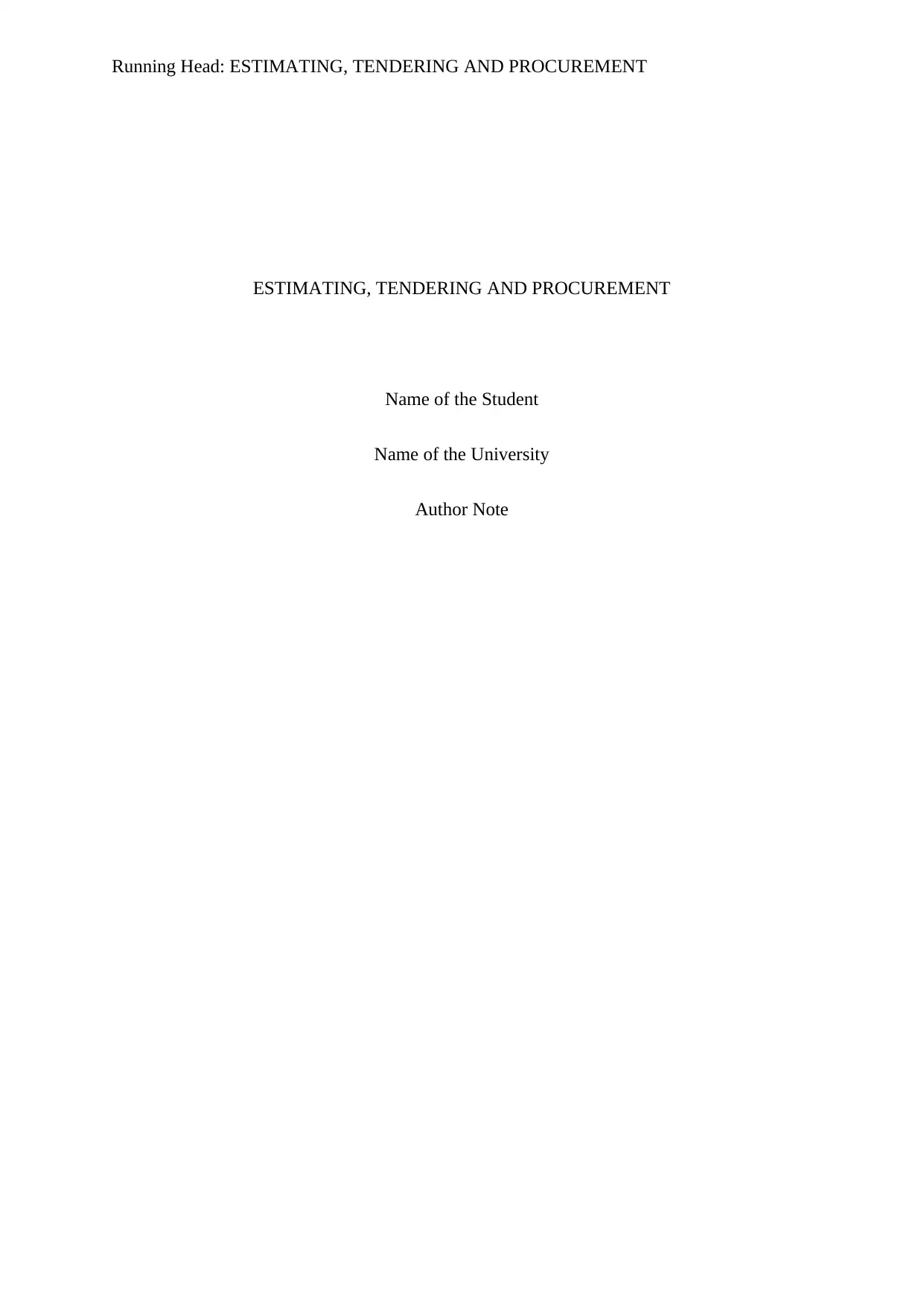
Running Head: ESTIMATING, TENDERING AND PROCUREMENT
ESTIMATING, TENDERING AND PROCUREMENT
Name of the Student
Name of the University
Author Note
ESTIMATING, TENDERING AND PROCUREMENT
Name of the Student
Name of the University
Author Note
Paraphrase This Document
Need a fresh take? Get an instant paraphrase of this document with our AI Paraphraser
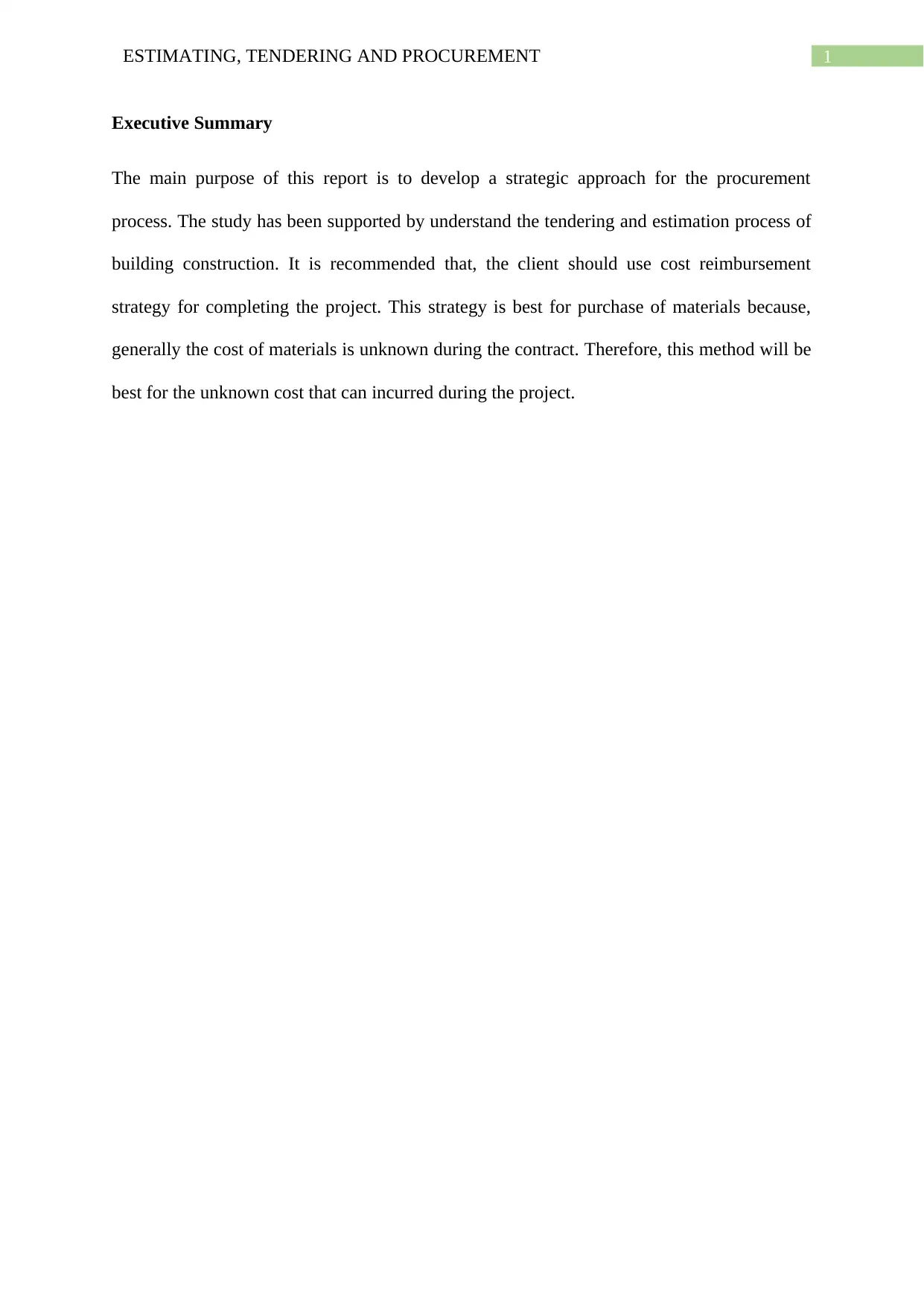
1ESTIMATING, TENDERING AND PROCUREMENT
Executive Summary
The main purpose of this report is to develop a strategic approach for the procurement
process. The study has been supported by understand the tendering and estimation process of
building construction. It is recommended that, the client should use cost reimbursement
strategy for completing the project. This strategy is best for purchase of materials because,
generally the cost of materials is unknown during the contract. Therefore, this method will be
best for the unknown cost that can incurred during the project.
Executive Summary
The main purpose of this report is to develop a strategic approach for the procurement
process. The study has been supported by understand the tendering and estimation process of
building construction. It is recommended that, the client should use cost reimbursement
strategy for completing the project. This strategy is best for purchase of materials because,
generally the cost of materials is unknown during the contract. Therefore, this method will be
best for the unknown cost that can incurred during the project.
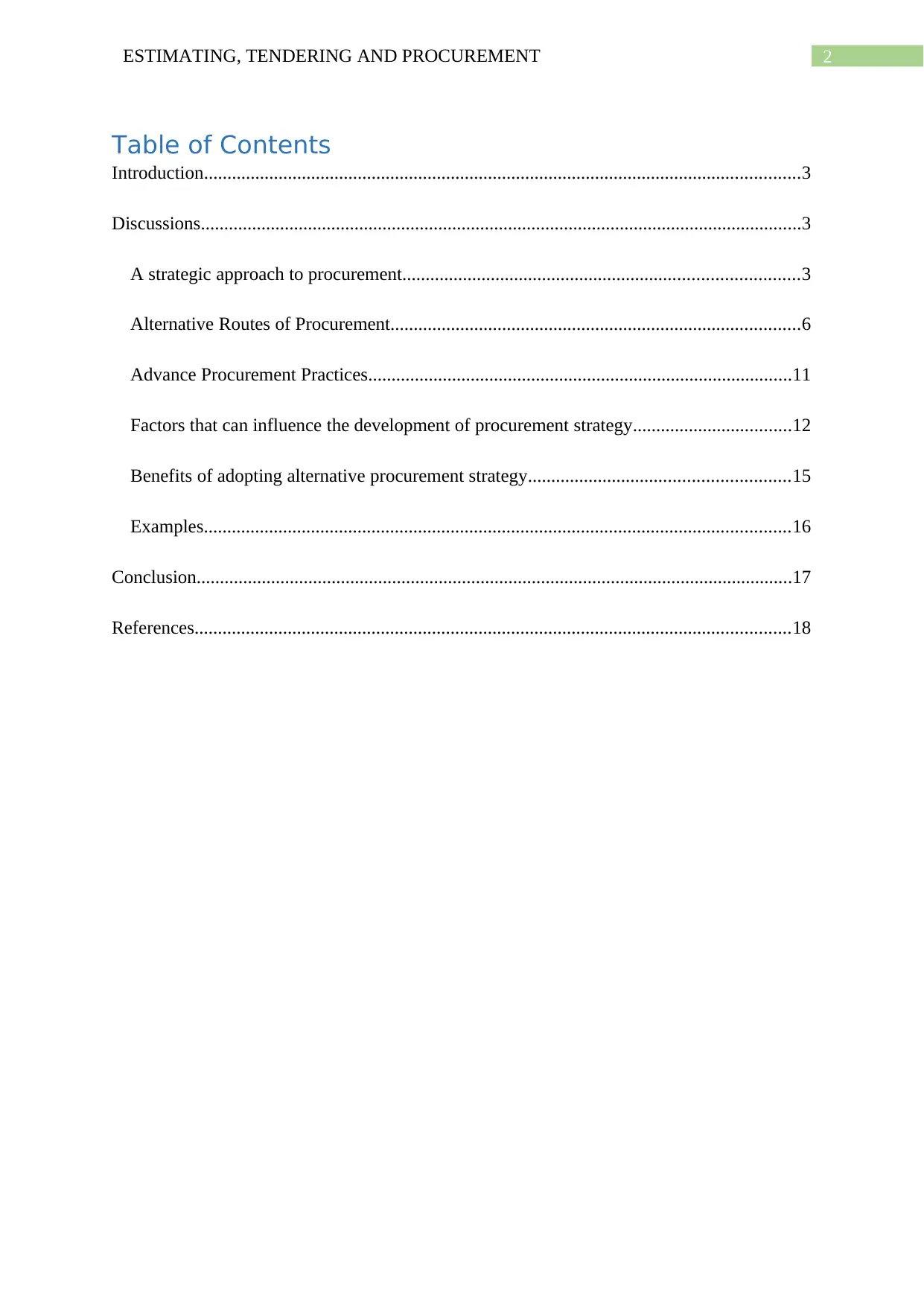
2ESTIMATING, TENDERING AND PROCUREMENT
Table of Contents
Introduction................................................................................................................................3
Discussions.................................................................................................................................3
A strategic approach to procurement.....................................................................................3
Alternative Routes of Procurement........................................................................................6
Advance Procurement Practices...........................................................................................11
Factors that can influence the development of procurement strategy..................................12
Benefits of adopting alternative procurement strategy........................................................15
Examples..............................................................................................................................16
Conclusion................................................................................................................................17
References................................................................................................................................18
Table of Contents
Introduction................................................................................................................................3
Discussions.................................................................................................................................3
A strategic approach to procurement.....................................................................................3
Alternative Routes of Procurement........................................................................................6
Advance Procurement Practices...........................................................................................11
Factors that can influence the development of procurement strategy..................................12
Benefits of adopting alternative procurement strategy........................................................15
Examples..............................................................................................................................16
Conclusion................................................................................................................................17
References................................................................................................................................18
⊘ This is a preview!⊘
Do you want full access?
Subscribe today to unlock all pages.

Trusted by 1+ million students worldwide
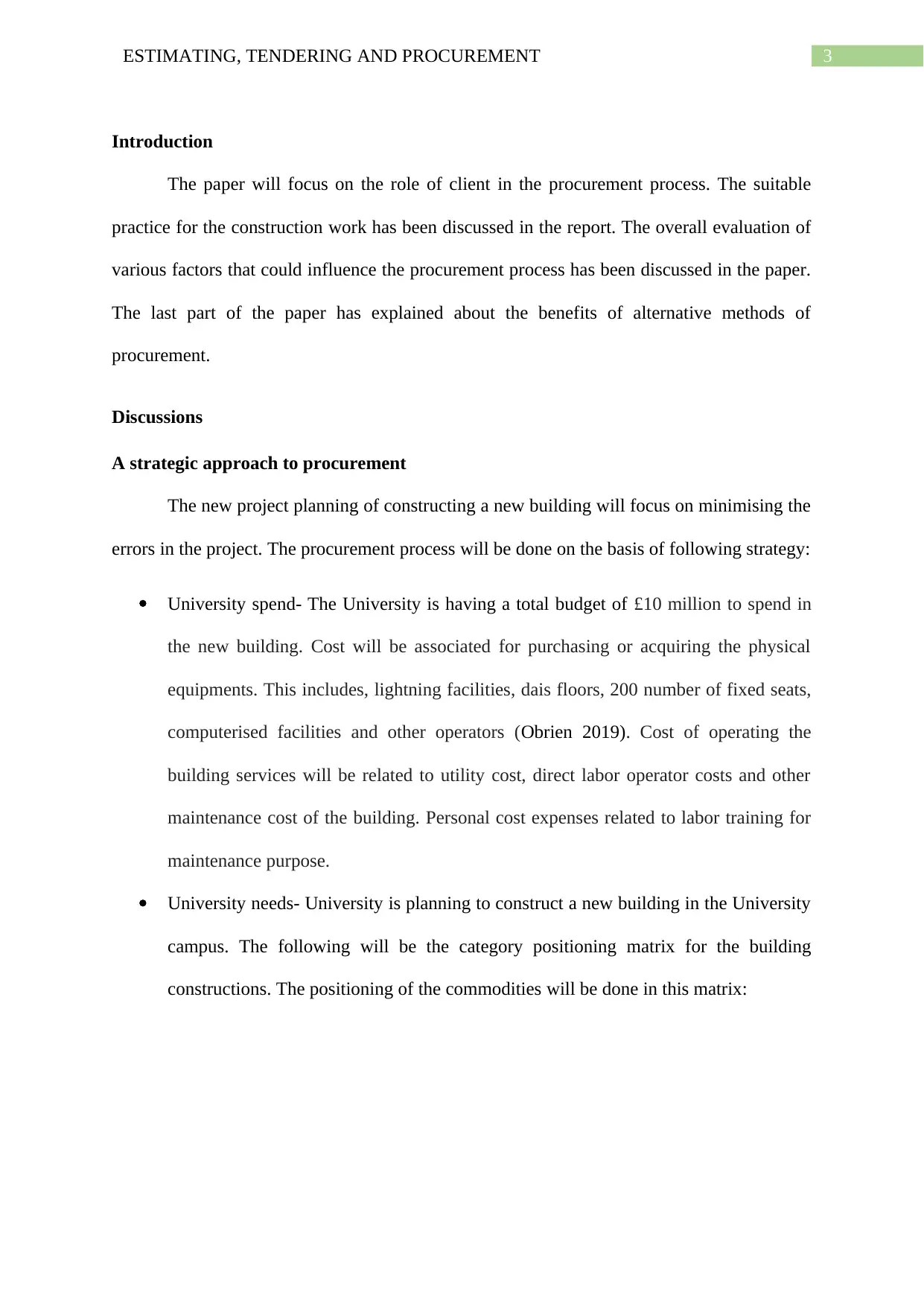
3ESTIMATING, TENDERING AND PROCUREMENT
Introduction
The paper will focus on the role of client in the procurement process. The suitable
practice for the construction work has been discussed in the report. The overall evaluation of
various factors that could influence the procurement process has been discussed in the paper.
The last part of the paper has explained about the benefits of alternative methods of
procurement.
Discussions
A strategic approach to procurement
The new project planning of constructing a new building will focus on minimising the
errors in the project. The procurement process will be done on the basis of following strategy:
University spend- The University is having a total budget of £10 million to spend in
the new building. Cost will be associated for purchasing or acquiring the physical
equipments. This includes, lightning facilities, dais floors, 200 number of fixed seats,
computerised facilities and other operators (Obrien 2019). Cost of operating the
building services will be related to utility cost, direct labor operator costs and other
maintenance cost of the building. Personal cost expenses related to labor training for
maintenance purpose.
University needs- University is planning to construct a new building in the University
campus. The following will be the category positioning matrix for the building
constructions. The positioning of the commodities will be done in this matrix:
Introduction
The paper will focus on the role of client in the procurement process. The suitable
practice for the construction work has been discussed in the report. The overall evaluation of
various factors that could influence the procurement process has been discussed in the paper.
The last part of the paper has explained about the benefits of alternative methods of
procurement.
Discussions
A strategic approach to procurement
The new project planning of constructing a new building will focus on minimising the
errors in the project. The procurement process will be done on the basis of following strategy:
University spend- The University is having a total budget of £10 million to spend in
the new building. Cost will be associated for purchasing or acquiring the physical
equipments. This includes, lightning facilities, dais floors, 200 number of fixed seats,
computerised facilities and other operators (Obrien 2019). Cost of operating the
building services will be related to utility cost, direct labor operator costs and other
maintenance cost of the building. Personal cost expenses related to labor training for
maintenance purpose.
University needs- University is planning to construct a new building in the University
campus. The following will be the category positioning matrix for the building
constructions. The positioning of the commodities will be done in this matrix:
Paraphrase This Document
Need a fresh take? Get an instant paraphrase of this document with our AI Paraphraser
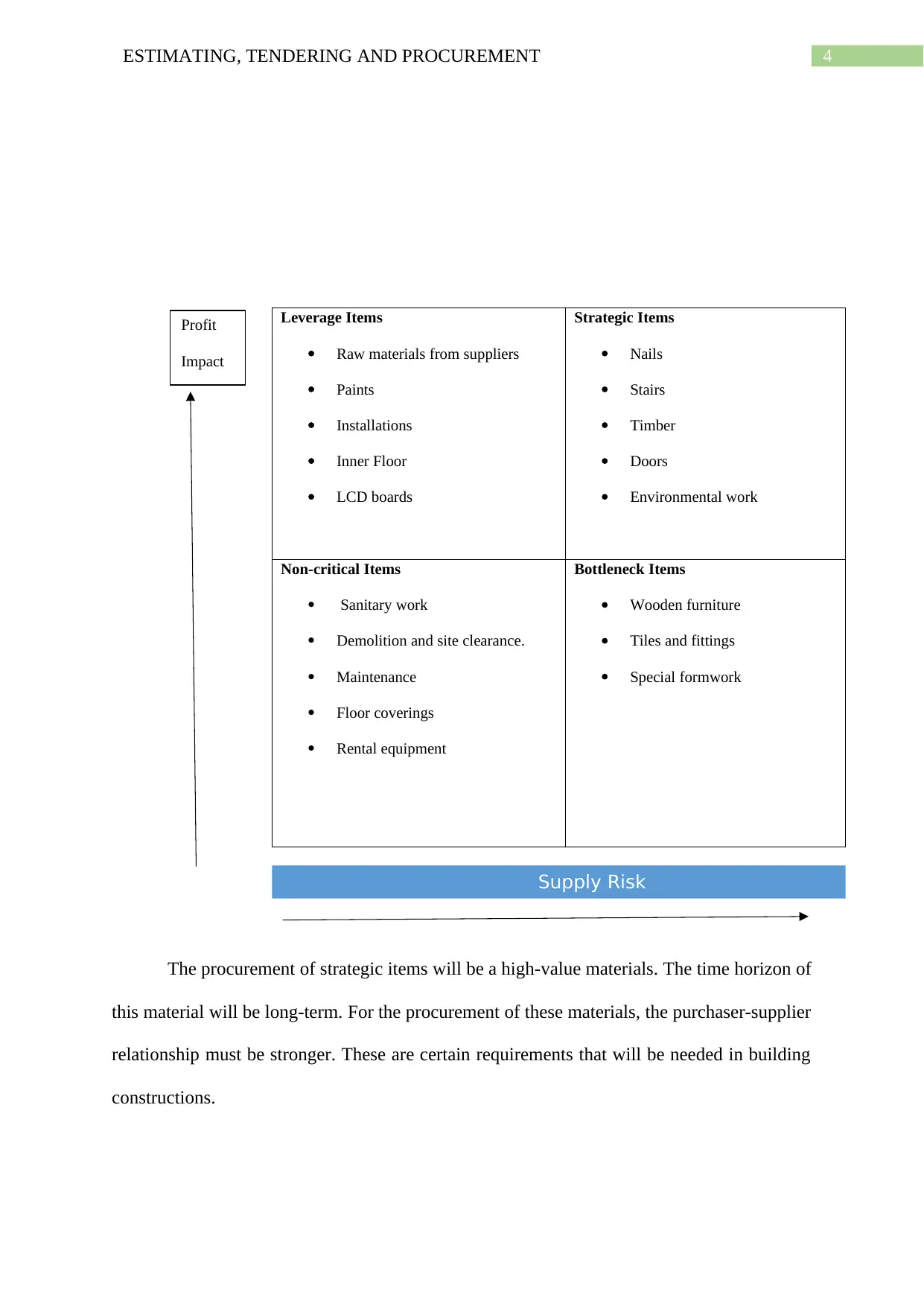
4ESTIMATING, TENDERING AND PROCUREMENT
Leverage Items
Raw materials from suppliers
Paints
Installations
Inner Floor
LCD boards
Strategic Items
Nails
Stairs
Timber
Doors
Environmental work
Non-critical Items
Sanitary work
Demolition and site clearance.
Maintenance
Floor coverings
Rental equipment
Bottleneck Items
Wooden furniture
Tiles and fittings
Special formwork
The procurement of strategic items will be a high-value materials. The time horizon of
this material will be long-term. For the procurement of these materials, the purchaser-supplier
relationship must be stronger. These are certain requirements that will be needed in building
constructions.
Supply Risk
Profit
Impact
Leverage Items
Raw materials from suppliers
Paints
Installations
Inner Floor
LCD boards
Strategic Items
Nails
Stairs
Timber
Doors
Environmental work
Non-critical Items
Sanitary work
Demolition and site clearance.
Maintenance
Floor coverings
Rental equipment
Bottleneck Items
Wooden furniture
Tiles and fittings
Special formwork
The procurement of strategic items will be a high-value materials. The time horizon of
this material will be long-term. For the procurement of these materials, the purchaser-supplier
relationship must be stronger. These are certain requirements that will be needed in building
constructions.
Supply Risk
Profit
Impact
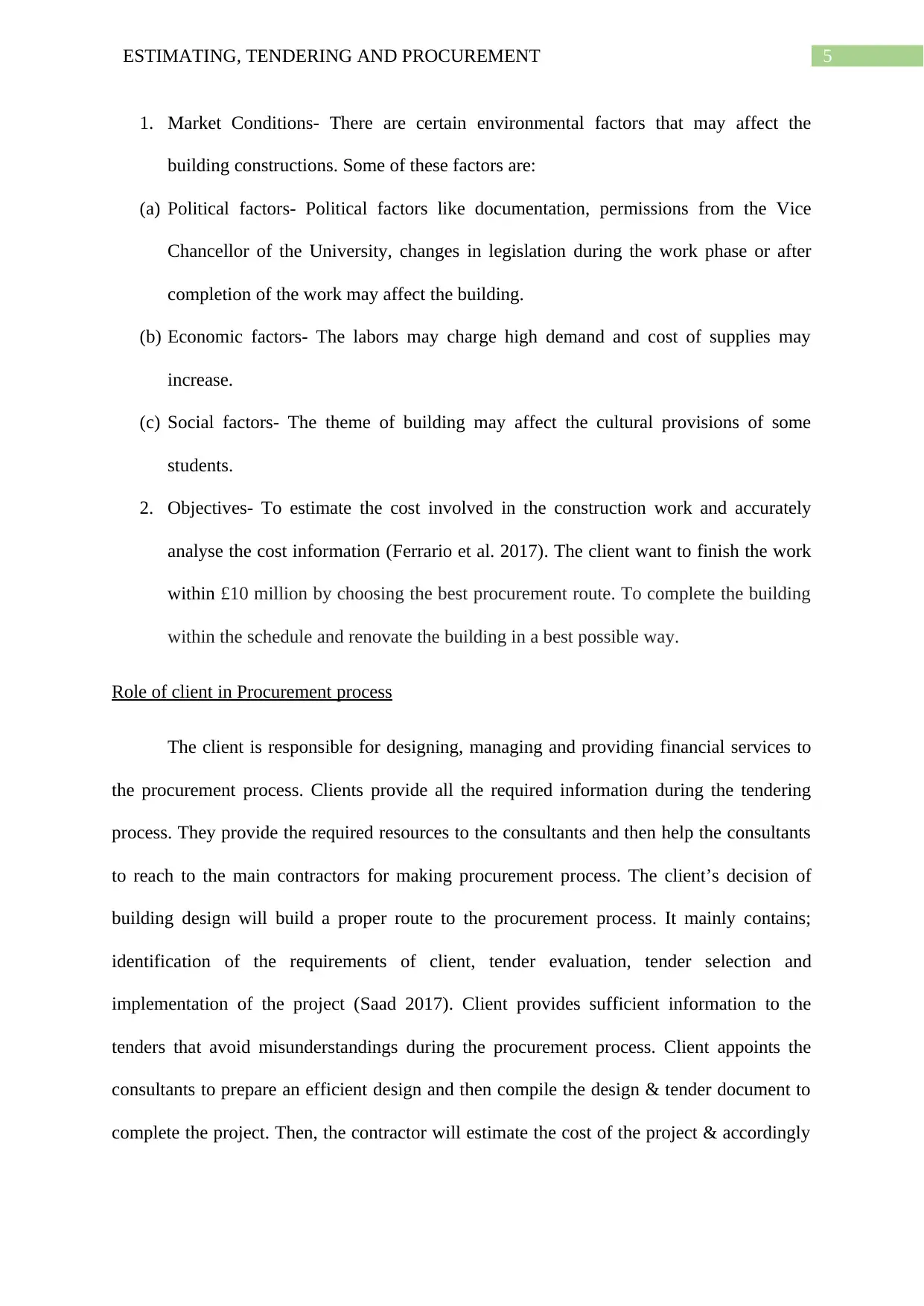
5ESTIMATING, TENDERING AND PROCUREMENT
1. Market Conditions- There are certain environmental factors that may affect the
building constructions. Some of these factors are:
(a) Political factors- Political factors like documentation, permissions from the Vice
Chancellor of the University, changes in legislation during the work phase or after
completion of the work may affect the building.
(b) Economic factors- The labors may charge high demand and cost of supplies may
increase.
(c) Social factors- The theme of building may affect the cultural provisions of some
students.
2. Objectives- To estimate the cost involved in the construction work and accurately
analyse the cost information (Ferrario et al. 2017). The client want to finish the work
within £10 million by choosing the best procurement route. To complete the building
within the schedule and renovate the building in a best possible way.
Role of client in Procurement process
The client is responsible for designing, managing and providing financial services to
the procurement process. Clients provide all the required information during the tendering
process. They provide the required resources to the consultants and then help the consultants
to reach to the main contractors for making procurement process. The client’s decision of
building design will build a proper route to the procurement process. It mainly contains;
identification of the requirements of client, tender evaluation, tender selection and
implementation of the project (Saad 2017). Client provides sufficient information to the
tenders that avoid misunderstandings during the procurement process. Client appoints the
consultants to prepare an efficient design and then compile the design & tender document to
complete the project. Then, the contractor will estimate the cost of the project & accordingly
1. Market Conditions- There are certain environmental factors that may affect the
building constructions. Some of these factors are:
(a) Political factors- Political factors like documentation, permissions from the Vice
Chancellor of the University, changes in legislation during the work phase or after
completion of the work may affect the building.
(b) Economic factors- The labors may charge high demand and cost of supplies may
increase.
(c) Social factors- The theme of building may affect the cultural provisions of some
students.
2. Objectives- To estimate the cost involved in the construction work and accurately
analyse the cost information (Ferrario et al. 2017). The client want to finish the work
within £10 million by choosing the best procurement route. To complete the building
within the schedule and renovate the building in a best possible way.
Role of client in Procurement process
The client is responsible for designing, managing and providing financial services to
the procurement process. Clients provide all the required information during the tendering
process. They provide the required resources to the consultants and then help the consultants
to reach to the main contractors for making procurement process. The client’s decision of
building design will build a proper route to the procurement process. It mainly contains;
identification of the requirements of client, tender evaluation, tender selection and
implementation of the project (Saad 2017). Client provides sufficient information to the
tenders that avoid misunderstandings during the procurement process. Client appoints the
consultants to prepare an efficient design and then compile the design & tender document to
complete the project. Then, the contractor will estimate the cost of the project & accordingly
⊘ This is a preview!⊘
Do you want full access?
Subscribe today to unlock all pages.

Trusted by 1+ million students worldwide
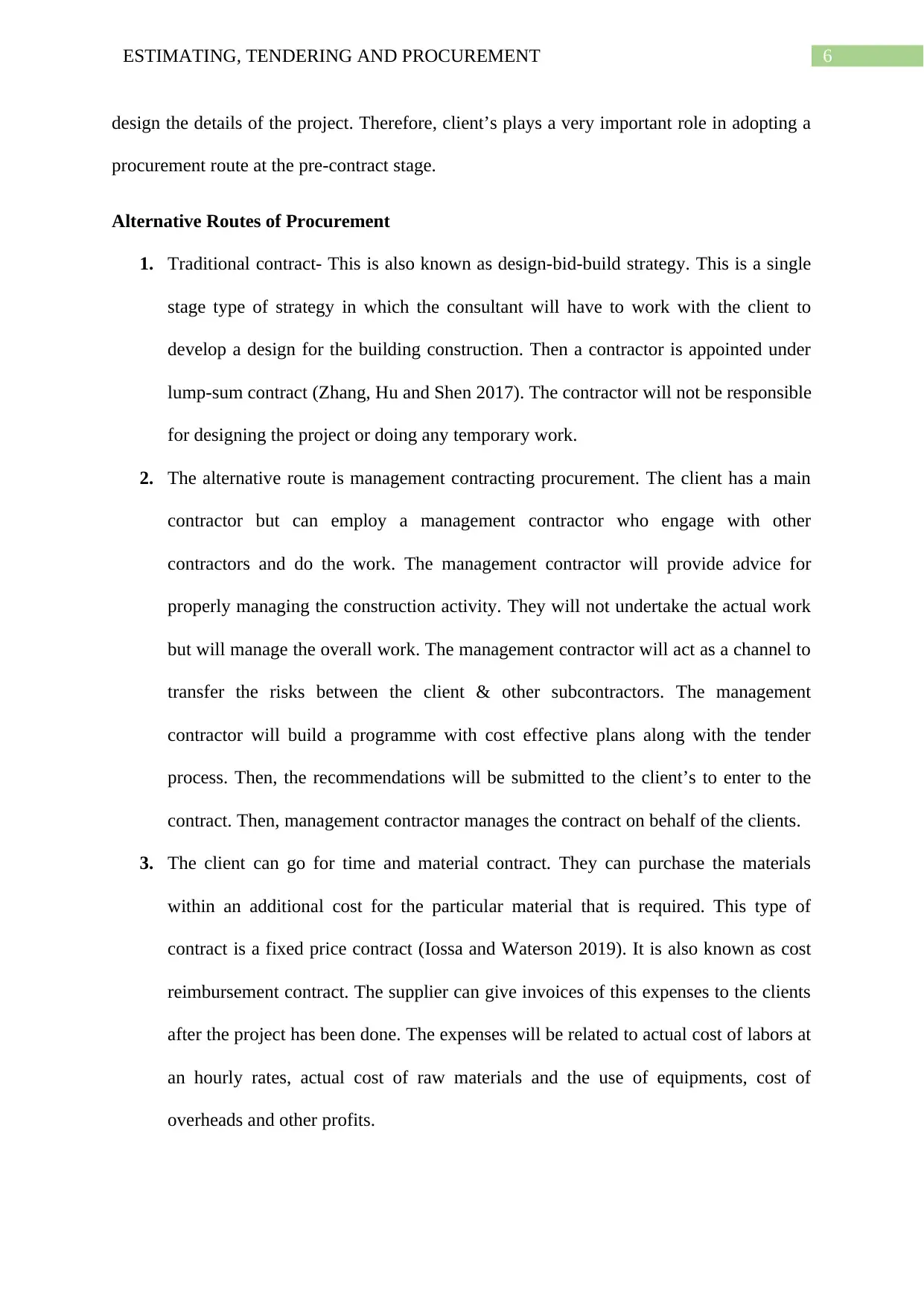
6ESTIMATING, TENDERING AND PROCUREMENT
design the details of the project. Therefore, client’s plays a very important role in adopting a
procurement route at the pre-contract stage.
Alternative Routes of Procurement
1. Traditional contract- This is also known as design-bid-build strategy. This is a single
stage type of strategy in which the consultant will have to work with the client to
develop a design for the building construction. Then a contractor is appointed under
lump-sum contract (Zhang, Hu and Shen 2017). The contractor will not be responsible
for designing the project or doing any temporary work.
2. The alternative route is management contracting procurement. The client has a main
contractor but can employ a management contractor who engage with other
contractors and do the work. The management contractor will provide advice for
properly managing the construction activity. They will not undertake the actual work
but will manage the overall work. The management contractor will act as a channel to
transfer the risks between the client & other subcontractors. The management
contractor will build a programme with cost effective plans along with the tender
process. Then, the recommendations will be submitted to the client’s to enter to the
contract. Then, management contractor manages the contract on behalf of the clients.
3. The client can go for time and material contract. They can purchase the materials
within an additional cost for the particular material that is required. This type of
contract is a fixed price contract (Iossa and Waterson 2019). It is also known as cost
reimbursement contract. The supplier can give invoices of this expenses to the clients
after the project has been done. The expenses will be related to actual cost of labors at
an hourly rates, actual cost of raw materials and the use of equipments, cost of
overheads and other profits.
design the details of the project. Therefore, client’s plays a very important role in adopting a
procurement route at the pre-contract stage.
Alternative Routes of Procurement
1. Traditional contract- This is also known as design-bid-build strategy. This is a single
stage type of strategy in which the consultant will have to work with the client to
develop a design for the building construction. Then a contractor is appointed under
lump-sum contract (Zhang, Hu and Shen 2017). The contractor will not be responsible
for designing the project or doing any temporary work.
2. The alternative route is management contracting procurement. The client has a main
contractor but can employ a management contractor who engage with other
contractors and do the work. The management contractor will provide advice for
properly managing the construction activity. They will not undertake the actual work
but will manage the overall work. The management contractor will act as a channel to
transfer the risks between the client & other subcontractors. The management
contractor will build a programme with cost effective plans along with the tender
process. Then, the recommendations will be submitted to the client’s to enter to the
contract. Then, management contractor manages the contract on behalf of the clients.
3. The client can go for time and material contract. They can purchase the materials
within an additional cost for the particular material that is required. This type of
contract is a fixed price contract (Iossa and Waterson 2019). It is also known as cost
reimbursement contract. The supplier can give invoices of this expenses to the clients
after the project has been done. The expenses will be related to actual cost of labors at
an hourly rates, actual cost of raw materials and the use of equipments, cost of
overheads and other profits.
Paraphrase This Document
Need a fresh take? Get an instant paraphrase of this document with our AI Paraphraser
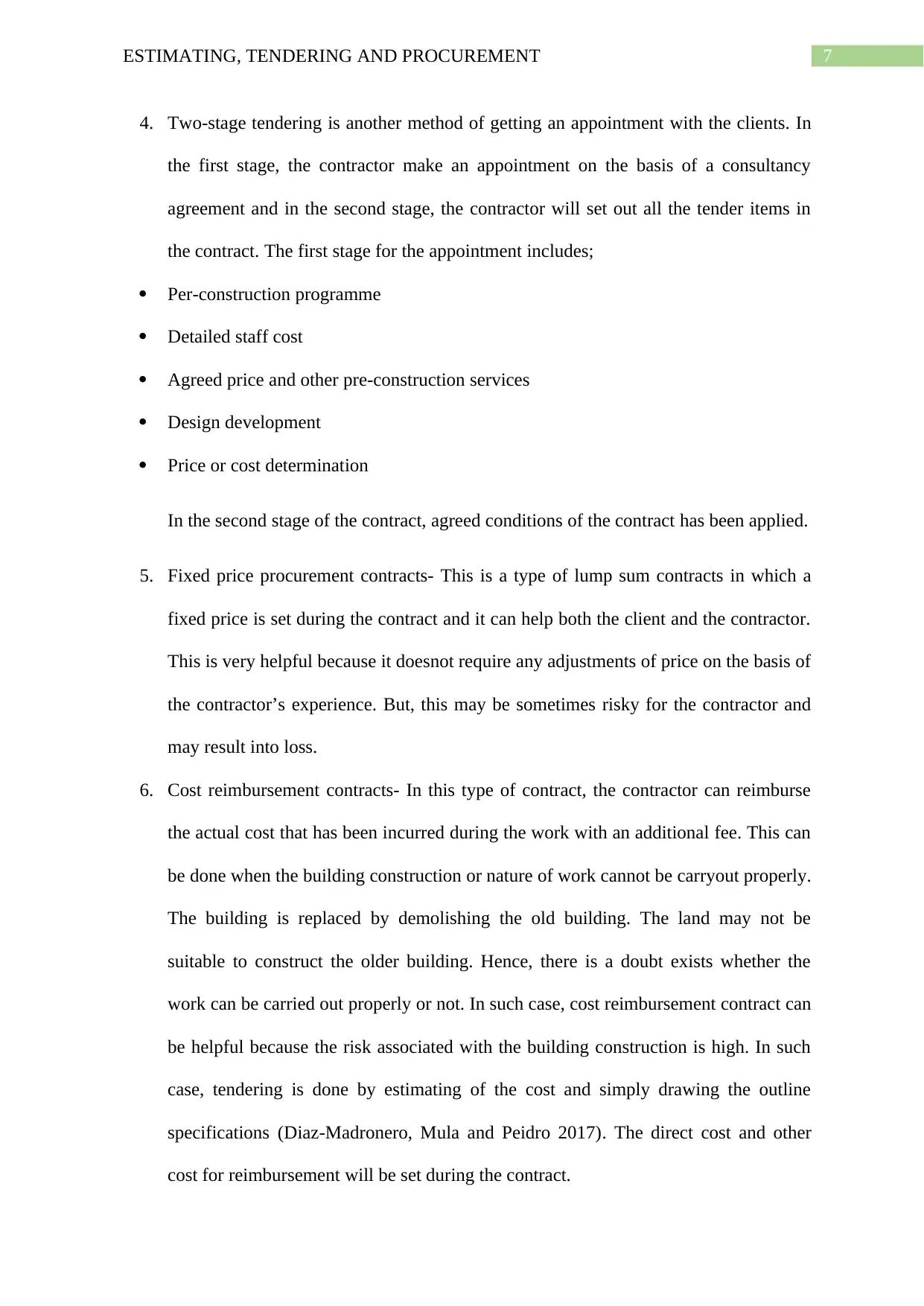
7ESTIMATING, TENDERING AND PROCUREMENT
4. Two-stage tendering is another method of getting an appointment with the clients. In
the first stage, the contractor make an appointment on the basis of a consultancy
agreement and in the second stage, the contractor will set out all the tender items in
the contract. The first stage for the appointment includes;
Per-construction programme
Detailed staff cost
Agreed price and other pre-construction services
Design development
Price or cost determination
In the second stage of the contract, agreed conditions of the contract has been applied.
5. Fixed price procurement contracts- This is a type of lump sum contracts in which a
fixed price is set during the contract and it can help both the client and the contractor.
This is very helpful because it doesnot require any adjustments of price on the basis of
the contractor’s experience. But, this may be sometimes risky for the contractor and
may result into loss.
6. Cost reimbursement contracts- In this type of contract, the contractor can reimburse
the actual cost that has been incurred during the work with an additional fee. This can
be done when the building construction or nature of work cannot be carryout properly.
The building is replaced by demolishing the old building. The land may not be
suitable to construct the older building. Hence, there is a doubt exists whether the
work can be carried out properly or not. In such case, cost reimbursement contract can
be helpful because the risk associated with the building construction is high. In such
case, tendering is done by estimating of the cost and simply drawing the outline
specifications (Diaz-Madronero, Mula and Peidro 2017). The direct cost and other
cost for reimbursement will be set during the contract.
4. Two-stage tendering is another method of getting an appointment with the clients. In
the first stage, the contractor make an appointment on the basis of a consultancy
agreement and in the second stage, the contractor will set out all the tender items in
the contract. The first stage for the appointment includes;
Per-construction programme
Detailed staff cost
Agreed price and other pre-construction services
Design development
Price or cost determination
In the second stage of the contract, agreed conditions of the contract has been applied.
5. Fixed price procurement contracts- This is a type of lump sum contracts in which a
fixed price is set during the contract and it can help both the client and the contractor.
This is very helpful because it doesnot require any adjustments of price on the basis of
the contractor’s experience. But, this may be sometimes risky for the contractor and
may result into loss.
6. Cost reimbursement contracts- In this type of contract, the contractor can reimburse
the actual cost that has been incurred during the work with an additional fee. This can
be done when the building construction or nature of work cannot be carryout properly.
The building is replaced by demolishing the old building. The land may not be
suitable to construct the older building. Hence, there is a doubt exists whether the
work can be carried out properly or not. In such case, cost reimbursement contract can
be helpful because the risk associated with the building construction is high. In such
case, tendering is done by estimating of the cost and simply drawing the outline
specifications (Diaz-Madronero, Mula and Peidro 2017). The direct cost and other
cost for reimbursement will be set during the contract.
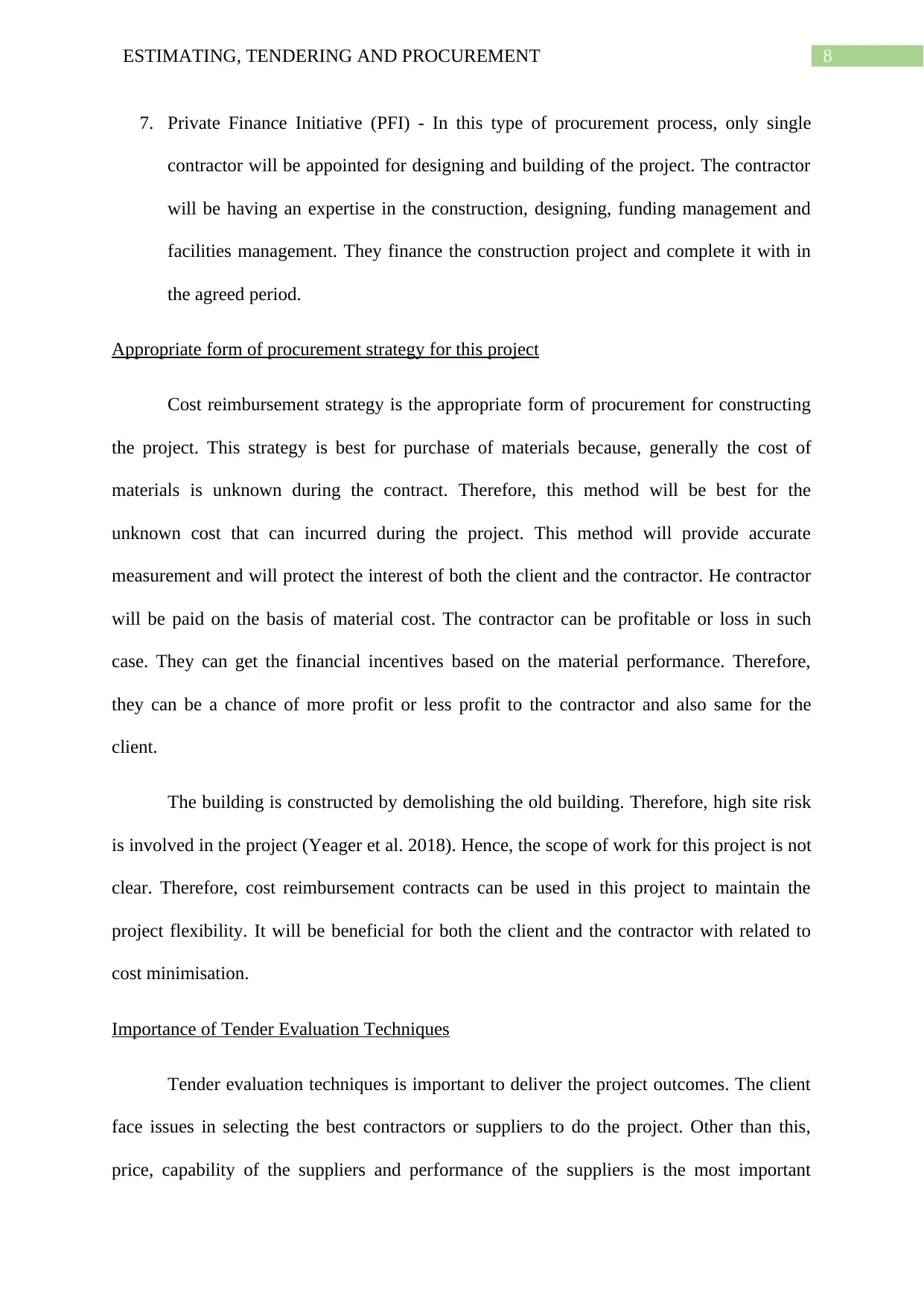
8ESTIMATING, TENDERING AND PROCUREMENT
7. Private Finance Initiative (PFI) - In this type of procurement process, only single
contractor will be appointed for designing and building of the project. The contractor
will be having an expertise in the construction, designing, funding management and
facilities management. They finance the construction project and complete it with in
the agreed period.
Appropriate form of procurement strategy for this project
Cost reimbursement strategy is the appropriate form of procurement for constructing
the project. This strategy is best for purchase of materials because, generally the cost of
materials is unknown during the contract. Therefore, this method will be best for the
unknown cost that can incurred during the project. This method will provide accurate
measurement and will protect the interest of both the client and the contractor. He contractor
will be paid on the basis of material cost. The contractor can be profitable or loss in such
case. They can get the financial incentives based on the material performance. Therefore,
they can be a chance of more profit or less profit to the contractor and also same for the
client.
The building is constructed by demolishing the old building. Therefore, high site risk
is involved in the project (Yeager et al. 2018). Hence, the scope of work for this project is not
clear. Therefore, cost reimbursement contracts can be used in this project to maintain the
project flexibility. It will be beneficial for both the client and the contractor with related to
cost minimisation.
Importance of Tender Evaluation Techniques
Tender evaluation techniques is important to deliver the project outcomes. The client
face issues in selecting the best contractors or suppliers to do the project. Other than this,
price, capability of the suppliers and performance of the suppliers is the most important
7. Private Finance Initiative (PFI) - In this type of procurement process, only single
contractor will be appointed for designing and building of the project. The contractor
will be having an expertise in the construction, designing, funding management and
facilities management. They finance the construction project and complete it with in
the agreed period.
Appropriate form of procurement strategy for this project
Cost reimbursement strategy is the appropriate form of procurement for constructing
the project. This strategy is best for purchase of materials because, generally the cost of
materials is unknown during the contract. Therefore, this method will be best for the
unknown cost that can incurred during the project. This method will provide accurate
measurement and will protect the interest of both the client and the contractor. He contractor
will be paid on the basis of material cost. The contractor can be profitable or loss in such
case. They can get the financial incentives based on the material performance. Therefore,
they can be a chance of more profit or less profit to the contractor and also same for the
client.
The building is constructed by demolishing the old building. Therefore, high site risk
is involved in the project (Yeager et al. 2018). Hence, the scope of work for this project is not
clear. Therefore, cost reimbursement contracts can be used in this project to maintain the
project flexibility. It will be beneficial for both the client and the contractor with related to
cost minimisation.
Importance of Tender Evaluation Techniques
Tender evaluation techniques is important to deliver the project outcomes. The client
face issues in selecting the best contractors or suppliers to do the project. Other than this,
price, capability of the suppliers and performance of the suppliers is the most important
⊘ This is a preview!⊘
Do you want full access?
Subscribe today to unlock all pages.

Trusted by 1+ million students worldwide
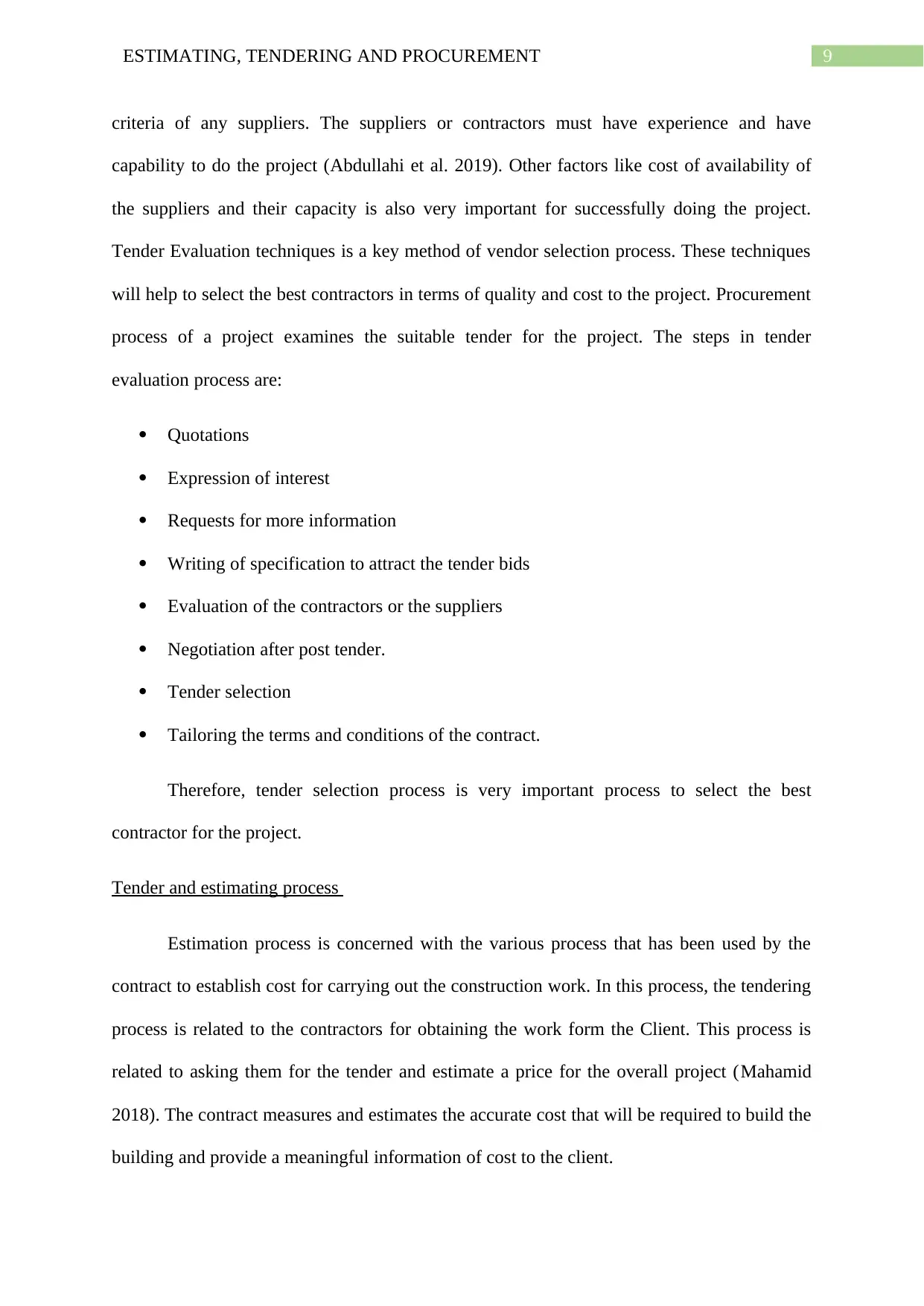
9ESTIMATING, TENDERING AND PROCUREMENT
criteria of any suppliers. The suppliers or contractors must have experience and have
capability to do the project (Abdullahi et al. 2019). Other factors like cost of availability of
the suppliers and their capacity is also very important for successfully doing the project.
Tender Evaluation techniques is a key method of vendor selection process. These techniques
will help to select the best contractors in terms of quality and cost to the project. Procurement
process of a project examines the suitable tender for the project. The steps in tender
evaluation process are:
Quotations
Expression of interest
Requests for more information
Writing of specification to attract the tender bids
Evaluation of the contractors or the suppliers
Negotiation after post tender.
Tender selection
Tailoring the terms and conditions of the contract.
Therefore, tender selection process is very important process to select the best
contractor for the project.
Tender and estimating process
Estimation process is concerned with the various process that has been used by the
contract to establish cost for carrying out the construction work. In this process, the tendering
process is related to the contractors for obtaining the work form the Client. This process is
related to asking them for the tender and estimate a price for the overall project (Mahamid
2018). The contract measures and estimates the accurate cost that will be required to build the
building and provide a meaningful information of cost to the client.
criteria of any suppliers. The suppliers or contractors must have experience and have
capability to do the project (Abdullahi et al. 2019). Other factors like cost of availability of
the suppliers and their capacity is also very important for successfully doing the project.
Tender Evaluation techniques is a key method of vendor selection process. These techniques
will help to select the best contractors in terms of quality and cost to the project. Procurement
process of a project examines the suitable tender for the project. The steps in tender
evaluation process are:
Quotations
Expression of interest
Requests for more information
Writing of specification to attract the tender bids
Evaluation of the contractors or the suppliers
Negotiation after post tender.
Tender selection
Tailoring the terms and conditions of the contract.
Therefore, tender selection process is very important process to select the best
contractor for the project.
Tender and estimating process
Estimation process is concerned with the various process that has been used by the
contract to establish cost for carrying out the construction work. In this process, the tendering
process is related to the contractors for obtaining the work form the Client. This process is
related to asking them for the tender and estimate a price for the overall project (Mahamid
2018). The contract measures and estimates the accurate cost that will be required to build the
building and provide a meaningful information of cost to the client.
Paraphrase This Document
Need a fresh take? Get an instant paraphrase of this document with our AI Paraphraser
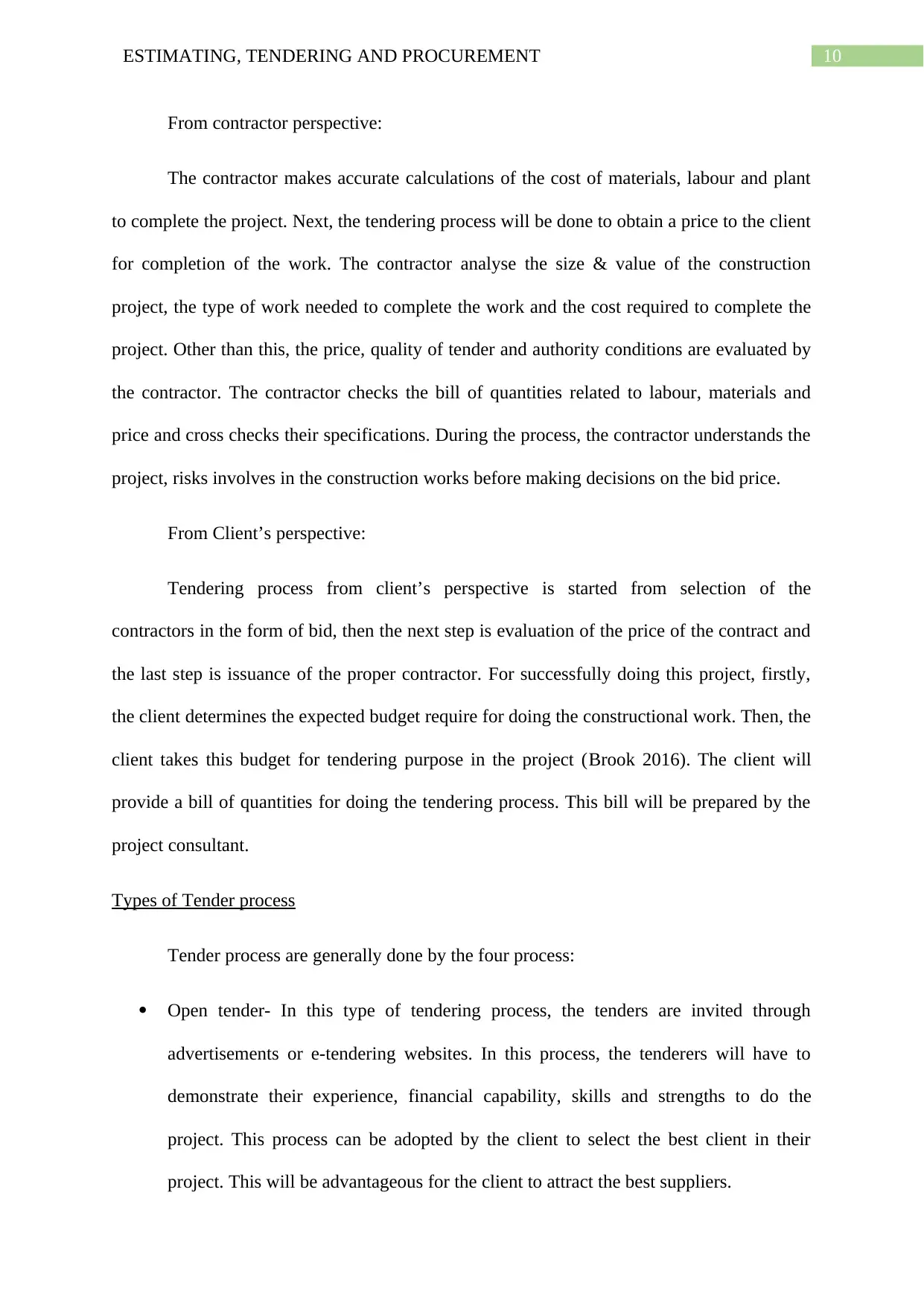
10ESTIMATING, TENDERING AND PROCUREMENT
From contractor perspective:
The contractor makes accurate calculations of the cost of materials, labour and plant
to complete the project. Next, the tendering process will be done to obtain a price to the client
for completion of the work. The contractor analyse the size & value of the construction
project, the type of work needed to complete the work and the cost required to complete the
project. Other than this, the price, quality of tender and authority conditions are evaluated by
the contractor. The contractor checks the bill of quantities related to labour, materials and
price and cross checks their specifications. During the process, the contractor understands the
project, risks involves in the construction works before making decisions on the bid price.
From Client’s perspective:
Tendering process from client’s perspective is started from selection of the
contractors in the form of bid, then the next step is evaluation of the price of the contract and
the last step is issuance of the proper contractor. For successfully doing this project, firstly,
the client determines the expected budget require for doing the constructional work. Then, the
client takes this budget for tendering purpose in the project (Brook 2016). The client will
provide a bill of quantities for doing the tendering process. This bill will be prepared by the
project consultant.
Types of Tender process
Tender process are generally done by the four process:
Open tender- In this type of tendering process, the tenders are invited through
advertisements or e-tendering websites. In this process, the tenderers will have to
demonstrate their experience, financial capability, skills and strengths to do the
project. This process can be adopted by the client to select the best client in their
project. This will be advantageous for the client to attract the best suppliers.
From contractor perspective:
The contractor makes accurate calculations of the cost of materials, labour and plant
to complete the project. Next, the tendering process will be done to obtain a price to the client
for completion of the work. The contractor analyse the size & value of the construction
project, the type of work needed to complete the work and the cost required to complete the
project. Other than this, the price, quality of tender and authority conditions are evaluated by
the contractor. The contractor checks the bill of quantities related to labour, materials and
price and cross checks their specifications. During the process, the contractor understands the
project, risks involves in the construction works before making decisions on the bid price.
From Client’s perspective:
Tendering process from client’s perspective is started from selection of the
contractors in the form of bid, then the next step is evaluation of the price of the contract and
the last step is issuance of the proper contractor. For successfully doing this project, firstly,
the client determines the expected budget require for doing the constructional work. Then, the
client takes this budget for tendering purpose in the project (Brook 2016). The client will
provide a bill of quantities for doing the tendering process. This bill will be prepared by the
project consultant.
Types of Tender process
Tender process are generally done by the four process:
Open tender- In this type of tendering process, the tenders are invited through
advertisements or e-tendering websites. In this process, the tenderers will have to
demonstrate their experience, financial capability, skills and strengths to do the
project. This process can be adopted by the client to select the best client in their
project. This will be advantageous for the client to attract the best suppliers.
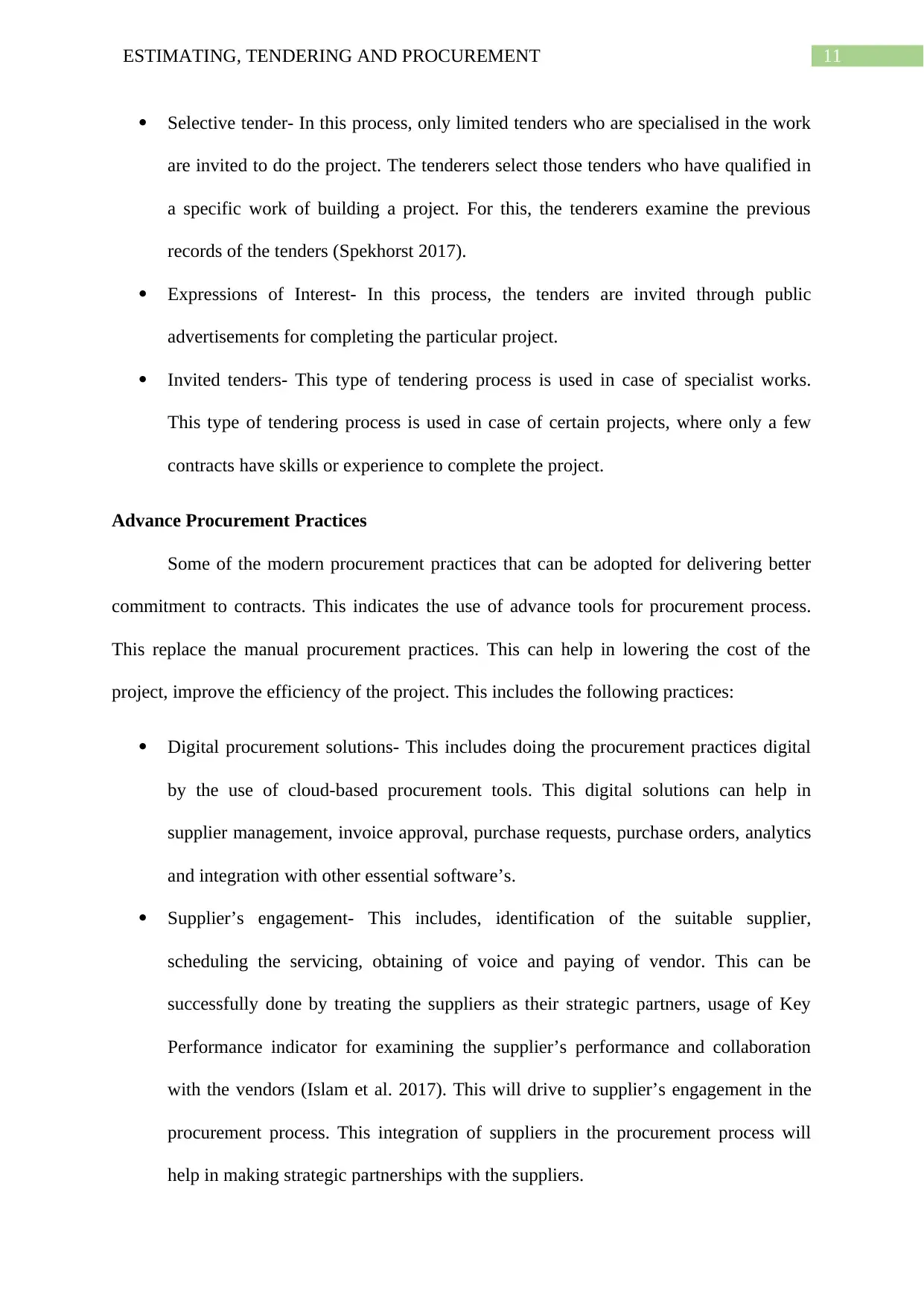
11ESTIMATING, TENDERING AND PROCUREMENT
Selective tender- In this process, only limited tenders who are specialised in the work
are invited to do the project. The tenderers select those tenders who have qualified in
a specific work of building a project. For this, the tenderers examine the previous
records of the tenders (Spekhorst 2017).
Expressions of Interest- In this process, the tenders are invited through public
advertisements for completing the particular project.
Invited tenders- This type of tendering process is used in case of specialist works.
This type of tendering process is used in case of certain projects, where only a few
contracts have skills or experience to complete the project.
Advance Procurement Practices
Some of the modern procurement practices that can be adopted for delivering better
commitment to contracts. This indicates the use of advance tools for procurement process.
This replace the manual procurement practices. This can help in lowering the cost of the
project, improve the efficiency of the project. This includes the following practices:
Digital procurement solutions- This includes doing the procurement practices digital
by the use of cloud-based procurement tools. This digital solutions can help in
supplier management, invoice approval, purchase requests, purchase orders, analytics
and integration with other essential software’s.
Supplier’s engagement- This includes, identification of the suitable supplier,
scheduling the servicing, obtaining of voice and paying of vendor. This can be
successfully done by treating the suppliers as their strategic partners, usage of Key
Performance indicator for examining the supplier’s performance and collaboration
with the vendors (Islam et al. 2017). This will drive to supplier’s engagement in the
procurement process. This integration of suppliers in the procurement process will
help in making strategic partnerships with the suppliers.
Selective tender- In this process, only limited tenders who are specialised in the work
are invited to do the project. The tenderers select those tenders who have qualified in
a specific work of building a project. For this, the tenderers examine the previous
records of the tenders (Spekhorst 2017).
Expressions of Interest- In this process, the tenders are invited through public
advertisements for completing the particular project.
Invited tenders- This type of tendering process is used in case of specialist works.
This type of tendering process is used in case of certain projects, where only a few
contracts have skills or experience to complete the project.
Advance Procurement Practices
Some of the modern procurement practices that can be adopted for delivering better
commitment to contracts. This indicates the use of advance tools for procurement process.
This replace the manual procurement practices. This can help in lowering the cost of the
project, improve the efficiency of the project. This includes the following practices:
Digital procurement solutions- This includes doing the procurement practices digital
by the use of cloud-based procurement tools. This digital solutions can help in
supplier management, invoice approval, purchase requests, purchase orders, analytics
and integration with other essential software’s.
Supplier’s engagement- This includes, identification of the suitable supplier,
scheduling the servicing, obtaining of voice and paying of vendor. This can be
successfully done by treating the suppliers as their strategic partners, usage of Key
Performance indicator for examining the supplier’s performance and collaboration
with the vendors (Islam et al. 2017). This will drive to supplier’s engagement in the
procurement process. This integration of suppliers in the procurement process will
help in making strategic partnerships with the suppliers.
⊘ This is a preview!⊘
Do you want full access?
Subscribe today to unlock all pages.

Trusted by 1+ million students worldwide
1 out of 21
Related Documents
Your All-in-One AI-Powered Toolkit for Academic Success.
+13062052269
info@desklib.com
Available 24*7 on WhatsApp / Email
![[object Object]](/_next/static/media/star-bottom.7253800d.svg)
Unlock your academic potential
Copyright © 2020–2025 A2Z Services. All Rights Reserved. Developed and managed by ZUCOL.




